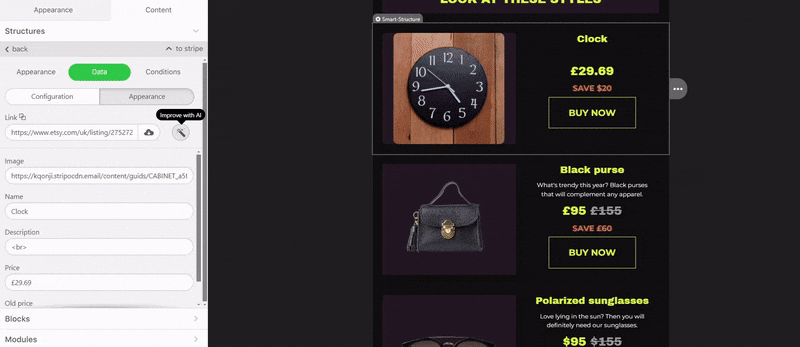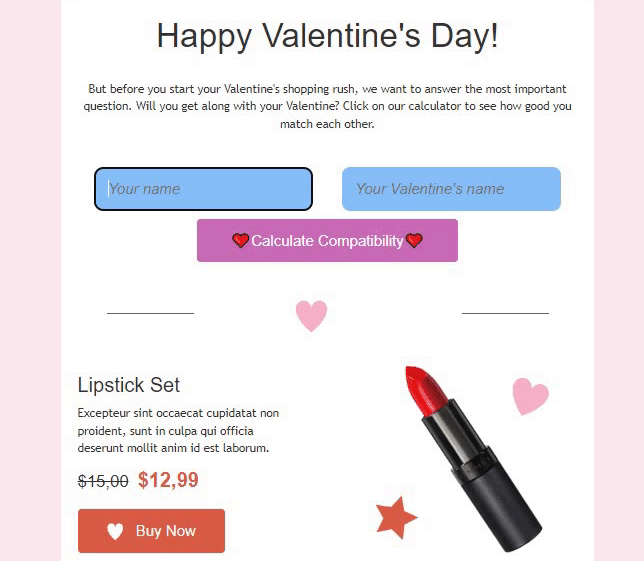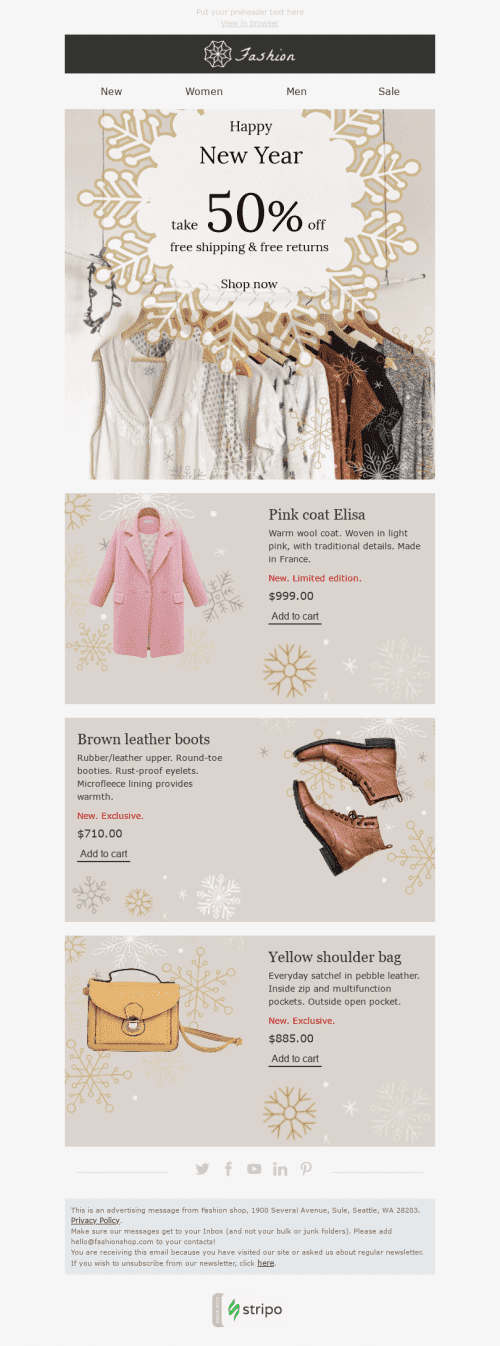Modular email design is a hot trend in email marketing because it can reduce the time it takes to create an email by up to five times, making the whole process more efficient. However, we believe that modules are much more than just well-designed, reusable email pieces. This innovative approach, which we call Modules+, will transform how email marketing teams operate, allowing marketers to focus more on big ideas rather than getting bogged down in technical details.
How it was before
This year, emails turned 52 years old, and over such a long time, the email design process has undergone many changes. First, there were simple text emails, and then creating emails became closely related to HTML programming. Later, marketers needed convenience and created WYSIWYG, where changes to the email are reflected immediately. Then came drag-n-drop editors that do not require technical knowledge to create emails.
How it is now
The evolution of email design didn’t stop with drag-n-drop editors and moved to prebuilt templates. Platforms continue to expand their range of templates, trying to please everyone in every case.
However, prebuilt templates have one major disadvantage. Once you choose a template for your campaigns, you’ll always have to modify it to meet the needs of your current email campaign. The world is still in the prebuilt template stage, but it is gradually moving toward modular design.
What is a module, and what are its benefits?
First of all, let’s talk about modules and modular email design in general. Think of your email like a Lego set. Lego is known for letting you build anything with its pieces. Modular email design works in much the same way. You have ready-made email parts, such as headers, product cards, and buttons, and you can rearrange them to easily create great emails.
Modular design is growing in popularity because of its inherent advantages:
- Easy to maintain brand consistency across email campaigns;
- time- and cost-effectiveness, since modules are created once and can be reused over and over;
- simplified email design process;
- no need to constantly test emails created with modules, as all modules are tested at the creation stage;
- a straightforward process for making changes to emails.
While basic modules give you great advantages in the email design process, there is one thing that can up your email game even more, and it’s called Modules+.
Why Modules+ is the next stage of email design
Modules+ is an improved version of Modules, and it offers several significant benefits and features. Let’s talk about them.
“Locked” design
The first feature that Modules+ brings to the table is a “locked” design. Once you’ve created a wireframe and defined its design styles, including image placement, you have the option to “lock” it. This means that no matter how many times you update the data within the module, the core design elements remain unchanged. This feature ensures that your modules always maintain their intended look and feel, giving you greater control and efficiency in your email marketing campaigns.
Option to create modules using smart elements
Smart elements provide the option to “lock” the data in the modules. This means you have the freedom to customize elements such as button colors, font size, and text color, all while ensuring that the data pulled into the module via a link remains unchanged. It’s the perfect balance between design flexibility and data reliability.
Smart elements are also a big help when combined with GenAI’s ability to create unified content across modules and entire emails. We found that such content performs well and takes less time to create.
| Human-written | AI-generated | |
| Recipients | 42,024 | 42,078 |
| CTOR | 8.72% | 8.02% |
We conducted our own research where we combined our smart elements feature with AI and taught it to put the necessary information into the appropriate fields of blog post annotations. As a result, we came to three positive conclusions:
- GenAI performs well when used correctly, even for complex things, such as entire modules.
- GenAI helps you create consistent content across modules and entire emails without human intervention. However, marketers can always check, optimize, and modify AI-generated copies.
- You can optimize email copy creation and save valuable time on strategy development by not manually creating emails.

Bulk updates
Updating multiple emails can also be simplified using synchronized modules. By modifying an existing synchronized module within just one template or email, those changes are automatically applied to all other templates or emails where you have used that module.
AMP and interactivity
You can build advanced modules featuring AMP content (games, carousels, quizzes, and much more), complete with HTML and fallbacks for email clients that don’t yet support interactivity.

At Stripo, we strive to provide marketers with different ways to add interactivity to their emails, regardless of their technical skills.
Our interactive module generator allows marketers to create various interactive elements (wheels of fortune, questionnaires, quiz puzzles, and much more) using a simple and intuitive interface outside of our editor. The finished interactive module will contain everything necessary for further use:
- AMP version of the module;
- interactive fallback for email clients that don’t support AMP;
- text fallback for email clients that don't support interactive content at all.
Our generator is an editor-independent tool, so the interactive modules it generates are independent content units that you can use wherever and however you want.
Generating emails
Modules+ with GenAI can help you generate emails. Using the API, you add modules with smart elements that are automatically filled with data retrieved from external data sources. You can make the system add as many modules as you need or use the same module as many times as you need, depending on the volume of your content.
For example, to generate a webinar invitation email using GenAI, you may need data that can be broken down into several levels:
- Basic data: simple data that GenAI can pull based on a prebuilt landing page for a webinar, such as title, date, and webinar description.
- Detailed information: the above data plus additional information, such as speakers, reason to attend, platform, and registration method.
- Extended data: Existing data scaled for all possible use cases (webinar date indicated in different time zones, links to save the event in different calendars, etc.).
- Supporting information: Data that helps sell the webinar (social proof, detailed speaker descriptions, announcements of Q&A sessions, behind-the-scenes content, etc.).
- Post-production information: Anything necessary to promote the webinar after it has been recorded, such as various presentations, webinar recordings with highlights, Q&A follow-ups, etc.
By combining this data with prebuilt templates and modules in them, AI can insert all of this data into the corresponding places in these modules with minimal involvement from the marketer.
The Modules+ approach: challenges to consider
When you start adopting the Modules+ approach, there is a high chance that you will encounter some challenges that you should be aware of.
Data code and variables
Keeping data and variable code separate from email design is crucial. Often, the final appearance of an email isn’t visible, and you can’t directly influence its design. Instead, you’re faced with a mix of code, logic, and variables, making it difficult to make independent design changes or preview the email using tools such as Litmus or Email on Acid.
Excluding logic
By keeping logic out of the formatting and data separate from the email design, you can avoid potential issues. Challenges such as varying lengths of product descriptions or missing product prices can sometimes disrupt the layout of the email, especially in product cards. This separation helps maintain a consistent and visually appealing email design, even when dealing with dynamic data.
Wrapping up
Modules+ is the next step in the evolution of the email design process, and ignoring it would not be a good business decision. Such upgrades are what the entire email marketing world is waiting for, as they allow the design process to be streamlined and time to be spent on strategic tasks instead of technical ones. Routine processes, such as manually updating all emails or constantly reworking ready-made templates, become obsolete thanks to modules and the Modules+ approach.










0 comments